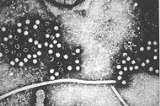
Hepatitis E virus
Encyclopedia
Hepatitis E virus is the infective organism that causes hepatitis E
.
The viral particles are 27 to 34 nanometers in diameter, are non-enveloped and contain a single-strand of positive-sense RNA
that is approximately 7300 bases in length. The virus particle was first visualised in 1983 but was only molecularly cloned in 1990.
It was previously classified family Caliciviridae
. However, its genome
more closely resembles the rubella virus
. It is now classified as the only member of the genus Hepevirus
, and that genus has not yet been assigned to a family.
Hepatitis E
Hepatitis E is a viral hepatitis caused by infection with a virus called hepatitis E virus . HEV is a positive-sense single-stranded RNA icosahedral virus with a 7.5 kilobase genome. HEV has a fecal-oral transmission route. It is one of five known hepatitis viruses: A, B, C, D, and E...
.
The viral particles are 27 to 34 nanometers in diameter, are non-enveloped and contain a single-strand of positive-sense RNA
RNA
Ribonucleic acid , or RNA, is one of the three major macromolecules that are essential for all known forms of life....
that is approximately 7300 bases in length. The virus particle was first visualised in 1983 but was only molecularly cloned in 1990.
It was previously classified family Caliciviridae
Caliciviridae
The Caliciviridae family are a family of viruses, members of Class IV of the Baltimore scheme. They are positive-sense, single stranded RNA which is non-segmented. The caliciviruses have been found in a number of organisms such as humans, cattle, pigs, cats, chickens, reptiles, dolphins and...
. However, its genome
Genome
In modern molecular biology and genetics, the genome is the entirety of an organism's hereditary information. It is encoded either in DNA or, for many types of virus, in RNA. The genome includes both the genes and the non-coding sequences of the DNA/RNA....
more closely resembles the rubella virus
Rubella
Rubella, commonly known as German measles, is a disease caused by the rubella virus. The name "rubella" is derived from the Latin, meaning little red. Rubella is also known as German measles because the disease was first described by German physicians in the mid-eighteenth century. This disease is...
. It is now classified as the only member of the genus Hepevirus
Hepevirus
Hepevirus is a viral genus with no currently assigned family. This genus is not to be confused with the Herpesvirus family. Hepevirus is a fairly isolated viral genus in which the virions are characterized by round, non-enveloped and isometric capsids with a diameter of 27-34 nm. The gene is...
, and that genus has not yet been assigned to a family.

